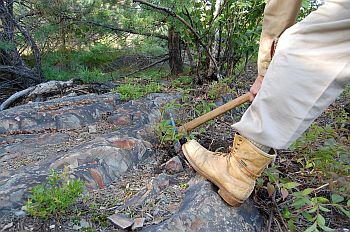 Who says money doesn't grow on trees?
Who says money doesn't grow on trees?
The Ontario Exploration Corporation (OEC) offers grants of up to $85,000 to qualified prospectors with properties of high economic potential.
The OEC began in April 2002 with a one-time $3-million grant from the Northern Ontario Heritage Fund Corporation. It replaced the Ontario Prospector's Assistance Program (OPAP), a no-strings-attached government grant program for prospectors.
The OEC is an independent for-profit corporation that gives financial assistance in exchange for a royalty on the mining lands. The program can provide up to $85,000 through a three-phase funding model. It initially awarded $3,000 grants, but that was increased to $10,000 within the last two years, said OEC president Joseph Barr.
"About two years ago, we took a survey and nobody was taking the money," Barr said. "The reason there wasn't much interest in the grants is that (investor) money was easy to obtain. If they could get $50,000, they wouldn't take five from us."
In the spring of 2008, the OEC came up with a new program that starts with a $10,000 grant to a qualified prospector with a claim in Ontario.
The prospector receives 50 per cent up front and 50 per cent after he or she files the first assessment report with the Ministry of Northern Development, Mines and Forestry, required within the year.
"That money can be used for literally anything except a per diem rate for the prospector," Barr said. "It will pay for a survey, line cutting...anything. When we give out the $10,000, we take a one per cent net smelter royalty (NSR), 0.75 per cent of which can be bought back. We will always retain one-quarter of one per cent."
The buy back can be transacted up to 11 years after the grant is awarded, but the cost increases every year.
Once the work related to the initial $10,000 grant is completed, the prospector can submit a second application for another $25,000. The application has to show that work has been done on the property and that it is worthy of more money. This is determined by an experienced independent evaluator. If accepted, the turnaround time is about three to four weeks. A third-phase applicant can receive up to $50,000.
Approximately 150 applications have been approved since the program's inception, totalling about $600,000. The program was also set up to invest up to $300,000 a year in junior mining companies.
The money is currently accruing interest, but Barr said he would prefer to invest it and support the prospecting industry.
"About 75 per cent think it is a wonderful plan," Barr said. "The other 25 per cent think it is too much paperwork and they don't want to give up the royalty."
"It's a good program because there is no interest on the money and you don't have to pay it back," Barr said. "If you go and stake a mining claim and you don't find anything, all you do is send notice that you are closing your claim and we write it off. It's not too often somebody will hand you $10,000."


.jpg;w=120;h=80;mode=crop)